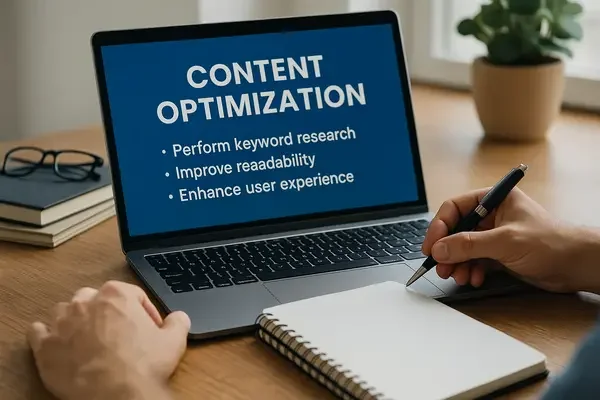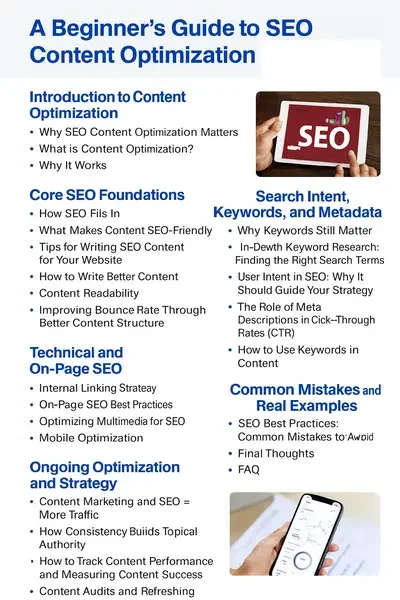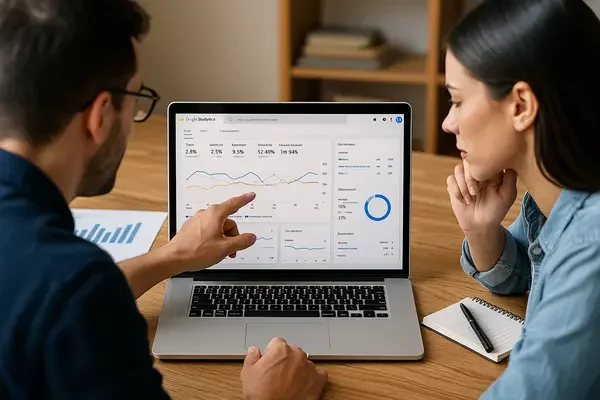Content Optimization: How to Improve Rankings and Traffic
If your content isn’t getting seen, it’s probably not optimized. That’s where content optimization techniques come in.
Table of Contents
These are the methods that help your content rank in search and make it easier for people to read and engage with. From keyword placement to layout and internal linking, the right content improvement strategy can make a big difference. If your content is helpful and easy to understand, both people and search engines can find it more easily.
Why SEO Content Optimization Matters
Just writing blog posts or web pages isn’t enough. If you want people to find your content, you need to optimize it. That means making sure it works for both your readers and search engines like Google.
Good SEO content strategy helps your site show up higher in search results. That means more people can find you, visit your site, and stay longer.
When your content matches what people are actually searching for, it’s more useful and more likely to perform well. That’s why learning how to optimize your content is so important.
What Is Content Optimization?
Content optimization is the process of improving your content so it's easier to find, read, and understand. You’re making your content better for both search engines and real people.
To do this, you’ll need to focus on a few things:
Picking the right keywords
Writing in a clear and simple way
Matching the content to what people are looking for
When done right, content improvements help your pages rank higher and get more traffic.
Why It Works
Here’s what content optimization can do:
Bring in more organic traffic
Make your content easier to understand
Help people stay on your site longer
Get your pages shared more often
Basically, it makes your content more useful and easier to find—which is the whole point.
How SEO Fits In
SEO (search engine optimization) is a big part of search-friendly content creation. It’s about making your content more visible in search engines like Google.
Some core SEO tactics include:
Using your target keywords in smart places
Writing strong meta descriptions
Adding alt text to your images
All of this helps search engines understand what your content is about, which makes it easier for them to rank it.
Also: SEO is always changing. If you want to keep ranking, you need to stay on top of updates and best practices.
What Makes Content SEO-Friendly
SEO-friendly content involves a lot more than stuffing keywords. It’s about writing clearly, staying organized, and making sure the content actually helps the reader.
Here’s what that usually includes:
Putting keywords in your headings and subheadings
Writing helpful meta titles and descriptions
Using bullet points or short paragraphs to improve readability
Search engines want to rank content that’s useful and clear. So focus on that first.
How SEO and Content Work Together
You can’t separate SEO from content. They go hand in hand.
Good content brings people in. SEO makes sure they can find it in the first place.
If your content isn’t optimized, people may never see it. If it’s not helpful, they won’t stick around. You need both.
Building a Simple Optimization Strategy
A solid content strategy plan should always include:
Researching keywords that your audience is actually searching for
Writing high-quality content that answers real questions
Using visuals where it makes sense
Update old content to keep it fresh
Keep your content aligned with your goals. Don’t publish just to publish.
How to Optimize Content for SEO
Here are a few things to focus on:
Use H1, H2, and H3 tags properly
Mobile optimization for the best user experience
Add internal links between related pages
Well-organized content helps readers—and it gives Google more context too.
Why Keywords Still Matter
Keywords tell search engines what your content is about. Don’t just stuff them into every sentence.
Instead, use them naturally in places like:
Titles
Headings
Image file names
The first 100 words of the page
Tips for Writing SEO Content Your Website
Start with the basics:
Make your site load fast
Make sure it works well on phones and tablets
Write in plain language
Keyword research
Also:
Use clear headings
Break up long blocks of text
Add visuals when they help tell the story
Use internal links to guide people around your site and help Google understand how your content connects.
In-Depth Keyword Research: Finding the Right Search Terms
Effective content strategy starts with smart keyword research. You need to understand what people are actually searching for and how those terms align with your business or topic.
First, figure out what your page is about. Then use tools like Google Search Console, Keywords Everywhere, SEOspace, or SEMrush to find broad and specific keywords. Long-tail keywords may have lower search volume but usually come with higher intent and lower competition.
Focus on search queries that reflect user intent. For example, someone searching “how to use keywords in content” is likely looking for a step-by-step guide, not a sales pitch.
Look for patterns in the queries:
Are people asking questions?
Looking for how-tos?
Comparing products?
This research is the foundation of your keyword optimization strategy. Every decision, structure, tone, headline, even visuals, should connect back to that initial keyword research.
Internal Linking Strategy
Internal linking helps both your readers and search engines navigate your site. It’s one of the easiest on-page SEO wins available.
Each time you create a new page or post, look for ways to link to and from relevant pages using descriptive anchor text. Don’t just say “click here.” Use natural language that reflects the topic of the linked page.
Here’s how internal linking supports organic visibility:
It helps distribute link equity across your site
Boosts page authority and topical relevance
Keeps users on your site longer by guiding them to more useful content
Avoid overlinking from a single page and make sure your links are actually helpful. Think of your site as an ecosystem where every page supports the next.
On-Page SEO Best Practices
On-page SEO is all about what you can control on the page itself.
Key areas to improve:
Title tags
Meta descriptions
URL structure
Image alt text
Your goal is to make each page easy to scan and easy to understand.
How to Write Better Content
Some best practices:
Start strong with a clear intro
Write short paragraphs
Avoid technical jargon
Add keywords where they fit naturally
Wrap up with a helpful conclusion
Give people what they came for. That’s what keeps them on the page.
Content Readability
Content readability matters for both people and search engines. Even AI tools, like the ones Google uses, look at how clear and easy your writing is. If your content is clear and easy to follow, search engines can figure out what it’s about and show it to more people. Improving readability helps your content connect with both readers and search engines.
User Intent in SEO: Why It Should Guide Your Strategy
Understanding user intent in SEO is key to building content that actually ranks. Google doesn’t just look at keywords anymore. It tries to understand what the user really wants when they type a search query.
There are four common types of search intent:
Informational (e.g. "how to optimize content for SEO")
Navigational (e.g. "portal login")
Transactional (e.g. "buy property management services")
Commercial investigation (e.g. "best property manager in 2025")
When you align your content to user intent, you increase the chances it will rank and convert. For example, if someone searches “what helps content rank on Google,” your post should give answers, not just talk about your business.
To match intent:
Check the top 5–10 results for your target keyword. What type of content do they show?
Make sure your page format and headline match what’s already working.
Use related queries and long-tail variations to expand your reach.
Your meta description doesn’t change your ranking, but it can help more people click your link in search results.
The Role of Meta Descriptions in Click-Through Rates (CTR)
Your meta description doesn’t change your ranking, but it can help more people click your link in search results. That’s why it’s a critical piece of your readability improvement strategy. Think of the meta description as ad copy for your page.
It should:
Be between 150 and 160 characters
Include your main keyword
Highlight the value of clicking
Match the user intent behind the search
For example, if someone searches “what does SEO-friendly mean,” your meta description should quickly explain what they'll learn on the page.
Avoid using duplicate meta descriptions across pages. Custom descriptions tailored to each post can improve click-through rate (CTR) and send positive signals to search engines.
Also, make sure the meta description delivers on its promise. If users land on your page and bounce because the content doesn’t match the description, your ranking may drop over time.
A good meta description increases organic traffic and supports every other part of your content quality enhancements.
Content Marketing and SEO = More Traffic
Optimized content supports your overall marketing. It brings in more search traffic, helps build trust, and makes your other efforts (like email or social media) more effective.
Some ways to boost that impact:
Create content for specific groups of people
Share your content across platforms
Keep your message and tone consistent
If you use all of these techniques, you will improve visibility.
How Consistency Builds Topical Authority
Search engines reward websites that show topical authority. That means consistently publishing content around a specific subject so Google sees your site as a trusted resource.
Let’s say your focus is content performance strategy. One blog post won’t be enough to build authority. You need a cluster of high-quality content that covers all angles:
What is content optimization?
How to use keywords in content
Tips for writing SEO content
Common mistakes to avoid
How content refinement improves traffic
This strategy is sometimes called a content hub or topic cluster. It helps with internal linking, improves content visibility, and keeps readers engaged longer.
Consistency also gives you more chances to rank. Each post can target a slightly different long-tail keyword or search intent. Over time, these posts support each other and build momentum.
Make sure your content calendar includes regular updates and audits of older content too. Updating pages helps maintain authority and shows Google your content is still relevant.
In short, consistency builds trust. And trust is what helps you move from page two to page one.
Content Optimization: How to Improve Rankings and Traffic
If your content isn’t getting seen, it’s probably not optimized. That’s where content strategy techniques come in.
From keyword placement to layout and internal linking, the right strategic content plan can make a big difference. When your content meets both reader needs and search engine requirements, it’s more likely to rank well and bring in steady traffic.
How to Track Content Performance and Measuring Content Success
To know what’s working, track things like:
Organic traffic over time
Bounce rate (how fast people leave your page)
How many people take action (like signing up or buying)
Track your query search rankings
Use this data to make better decisions moving forward.
Improving Bounce Rate Through Better Content Structure
Bounce rate is the percentage of people who visit a page and leave without clicking anything else. While it’s not always a bad sign, a high bounce rate usually means the page isn’t meeting expectations.
Conversion-focused content development can help reduce bounce rate and keep users on your site longer.
Start by improving your content readability. Use short paragraphs, bullet points, and subheadings to break up the text. This helps readers scan quickly and find what they need. Also, place the most important info near the top of the page.
Add internal links early in the content, not just at the end. Direct readers to related posts that help them go deeper.
When you write a post about strategic content development, include links to useful articles. For example, you can link to posts about how to use keywords in your content or what on-page SEO is. This helps readers find more information and improves your post’s value.
Visuals help too. Add optimized images and charts to increase engagement and support the content.
When your content is clear and well-structured, more people will enjoy it. This increases the chances that Google will highlight it in a featured snippet.
Bonus: It helps search engine algorithms better understand the hierarchy of your content.
SEO Best Practices: Common Mistakes to Avoid
Content streamlining can backfire if you’re not careful.
Watch out for:
Writing for search engines, not real people
Stuffing too many keywords
Forgetting about mobile users
Bad content won’t perform—no matter how optimized it looks on paper.
How to Use Keywords in Content
Avoid keyword stuffing. It makes your content hard to read and it can hurt your rankings. Use your target keywords a few times, but always focus on clarity first.
Real-World Example: Content Optimization in Action
Let’s say you had a blog post called “Why My Content Isn’t Ranking” that wasn’t getting much traffic.
After doing a content audit, you discovered:
The post had no internal links
The target keyword wasn’t in the title
It lacked a meta description
You changed the title to include "SEO content enhancement." You also added keywords at the beginning of the introduction, linked to related posts, and used an image with alt text.
After the refresh, you tracked performance:
Organic traffic doubled in 30 days
The post jumped from page 4 to page 1
Bounce rate dropped by 20%
That’s the power of basic content improvement techniques applied with consistency.
Optimizing Multimedia for SEO
Images, videos, and infographics boost engagement and help break up long text. But they need to be optimized to support your content engagement strategy.
Key things to focus on:
Add descriptive alt text using relevant keywords
Compress images for faster loading (use WebP or compressed JPEGs)
Use keyword-rich file names (e.g., “content-optimization-example.jpg”)
For videos:
Add a short transcript for accessibility and SEO
Use relevant titles and tags
Multimedia increases dwell time on a page and helps pages rank higher when optimized correctly.
Mobile Optimization
Google now uses mobile-first indexing, meaning it looks at your mobile site before your desktop version. That makes mobile optimization a must.
Here’s how to do it:
Use a responsive design so your site looks good on any screen
Keep page load speed under 3 seconds
Avoid elements that don’t work on smaller devices (like hover menus)
You can test your site using Google’s Mobile-Friendly Test.
A website that is easy to use on phones improves user experience. This can also help your site rank higher in search results, especially for local searches.
Content Audits and Refreshing Old Posts
Updating your old content is one of the most overlooked content performance techniques. Start by running a content audit using tools like Google Analytics.
Look for pages with:
Low traffic
High bounce rates
Outdated info
Weak internal linking
Then, refresh those pages by:
Rewriting weak paragraphs
Adding new keywords
Fixing internal and external links
Updating images and CTAs
Refreshed content often ranks better than brand new posts. It helps maintain your site’s authority and signals to Google that your site is active and relevant.
SEO Content Writing Checklist
Here’s a simple checklist to follow when writing SEO-friendly content:
Do keyword research first
Use target keywords in the first 100 words
Structure content with H1, H2, and H3 tags
Write short paragraphs for better content readability
Add internal and external links
Optimize images with alt text
Include a strong CTA
Check mobile performance
Add a meta title and description
Avoid keyword stuffing
This checklist keeps your content aligned with SEO goals and improves both content performance and readability.
Final Thoughts
Content strategy helps your content show up and stand out. When done right, it improves your rankings, boosts traffic, and keeps readers around longer.
The trick is to keep your content helpful, clear, and up to date. SEO brings people in. Good content keeps them there.
Frequently Asked Questions (FAQs)
-
SEO-friendly means content is written and structured so search engines can easily understand, index, and rank it. It includes using keywords, headers, clean URLs, internal linking, and meta tags.
-
If your content isn’t optimized, if it lacks keywords, structure, or doesn’t match user intent, it probably won’t rank well. A content optimization strategy can help fix that.
-
Start by learning how to optimize content for SEO. Focus on keywords, meta descriptions, and page structure. Then track your organic traffic to see what’s working.
-
Google looks for high-quality, helpful content. Use keywords naturally, format your page for readability, improve load speed, and update content regularly to keep it relevant.



